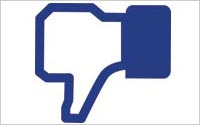
Finding the
return on investment from Facebook ads is a continuing source of concern for advertisers that are looking for answers on what they get in return for spending millions of dollars to advertise on the
site. It has become clear through General Motor's decision to pull ad funds that the industry needs to stop inventing new metrics and turn toward traditional tools.
While Facebook's
closed-wall environment creates challenges when it comes to analyzing data, research surfaced recently that allows advertisers to move beyond data from "Likes" to make social media more measurable.
The analysis points to measuring performance based on traditional offline methods, such as brand lift.
Facebook is not the only social platform that will require support from data analysis
tools. Google+, Twitter, and Pinterest will need support from traditional accountable ad metrics as well.
Gauging the value of an engagement on social media may seem difficult, but satisfying
Wall Street, advertisers and users will become "one massive effort," according to Steve Goldner, MediaWhiz's head of social media marketing. Vizu CEO Dan Beltramo points a finger at the entire
industry for several shortcomings -- including the release of measurement tools weekly by social media companies trying to create a new metric that praises their platform.
"Companies really
need to commit to a standard metric everyone can use," Beltramo said, suggesting that the industry should use brand lift. "A 'Like' as your only metric has no relation to any prior experience, and it
makes spending money on social advertising a risky proposition."
There are no shortage of success stories when it comes to measuring brand lift. A social media campaign for Jones New York
supported by digital publisher 33Across measured a 56% lift in purchase intent, up 19%. The agency relied on Vizu Ad Catalyst for Advertisers to measure the increase in awareness and the influence of
social media advertising.
General Electric (GE) had a similar experience with BuzzFeed using Vizu tools, measuring a lift in brand perception compared with those who had not seen the content.
Respondents viewed GE as a "creative" company resulting in a 138% brand lift via social media. Consumers discovering GE content through recommendation on Facebook posts, Twitter tweets, and email
links were 83% more likely to consider the company "creative," compared with those who found the content from within BuzzFeed.
Mary Kay and BlogHer drove an overall 259.6% lift in purchase
intent, or increased purchase intent by more than three times among those who had been exposed to a recent social media campaign.
Brand lift that is calculated by measuring the attitude of
people not exposed to the social media advertise, compared with the attitude of people who have been exposed when both groups start with identical experiences, can become a powerful metric. This would
show attitude, or brand lift, attributable to social media advertising. The key would be tracking exposure to social media advertising similar to traditional methods.
Vizu records everyone
exposed to an advertising campaign and surveys a subset to gain their opinion and attitudes about the brand. Then they survey an identical population of people about their opinion and attitudes about
the same brand, and looks for the differences in opinion. This process allows the company to identify those with more favorable opinions.